A first draft is a long way from done. So how do we get to done? Obviously, the next step after a first draft is a second draft. Right?
No, actually. The next step after a first draft involves making sure that it’s a PROFESSIONAL First Draft.
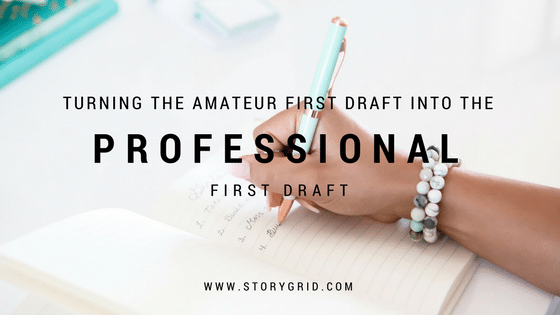
As Shawn Coyne says:
“An amateur first draft is a series of scenes that don’t have beginning, middles, and ends, that don’t have valence shifts, that don’t have any values at stake, that are riddled with clichés…There’s no real thought about the global movements of value shift for the chosen genre. Most likely the writer hasn’t even made a clear genre choice. So the obligatory scenes and conventions of the story the writer wants to tell are not on the page. There’s no global arc. It’s just 60,000 words one after the other. And it will most likely have to be put in a drawer. It’s not a first draft.”
Then what’s a Professional First Draft? Here’s my basic definition:
- The genre conventions are (mostly) there
- Each scene has a beginning, middle, and end
- The global story has a beginning, middle, and end
Unfortunately, most of the time our first attempt at a novel doesn’t arc properly and we don’t produce anything close to a Professional First Draft. It’s an Amateur First Draft, and not something you would want to spend hours and hours putting onto a Story Grid Spreadsheet.
Sure, you’ll be able to see in glorified living color that your draft doesn’t work, but a Story Grid Spreadsheet is an enormous investment of time. For many of us, we waffle between fear of The Spreadsheet and knowledge that we are NOT ready to benefit from it. This uncertainty can leave us hanging. We feel great that we’ve written a book, but we don’t know how to move forward without grinding out fourteen columns of pain.
The answer: put your first draft through a targeted rewrite to get it to the spreadsheet-worthy draft. Here’s a checklist of Amateur First Draft issues, all of which I discovered in two of my own manuscripts buried in a box under my desk. Use this list to cut out the dead wood and beef up the overall story arc in your first draft before embarking on the Story Grid Spreadsheet.
My 7-Step Process to Get to a Spreadsheet-Worthy First Draft
(click for a checklist-style PDF: Story Grid First Draft Checklist)
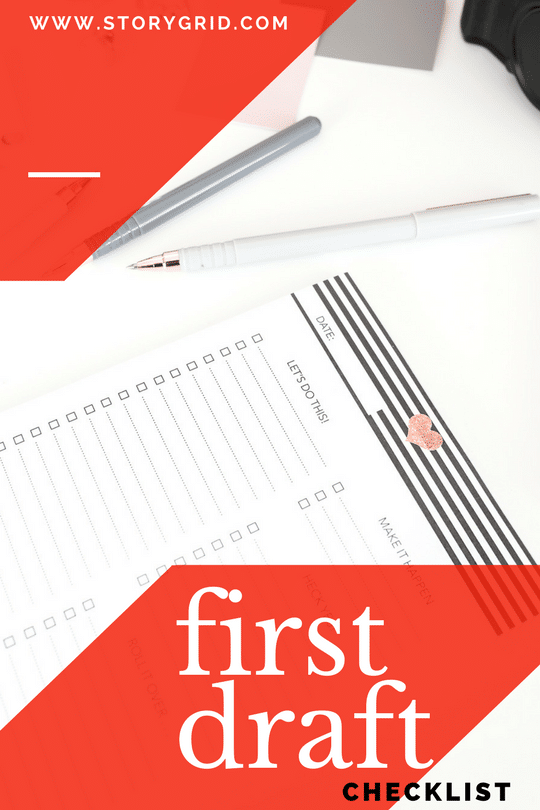
Make a list, find the dead wood
List out your scenes and number them; write a description of what happens that’s no more than a sentence or two, and note the word count of each scene. I recommend that you use a method that allows you to see all of your scenes at once, in order. I use Ulysses, and put each scene on a “sheet.” You can use Scrivener, which will give you a similar view, as well as its corkboard view. You can also use a notebook or index cards, or even a spreadsheet. Don’t overthink this; the description of each scene should be the answer to the question, “What happens?” If you find scenes that don’t “turn,” flag those, because you will need to either delete them or fix them—but not yet.
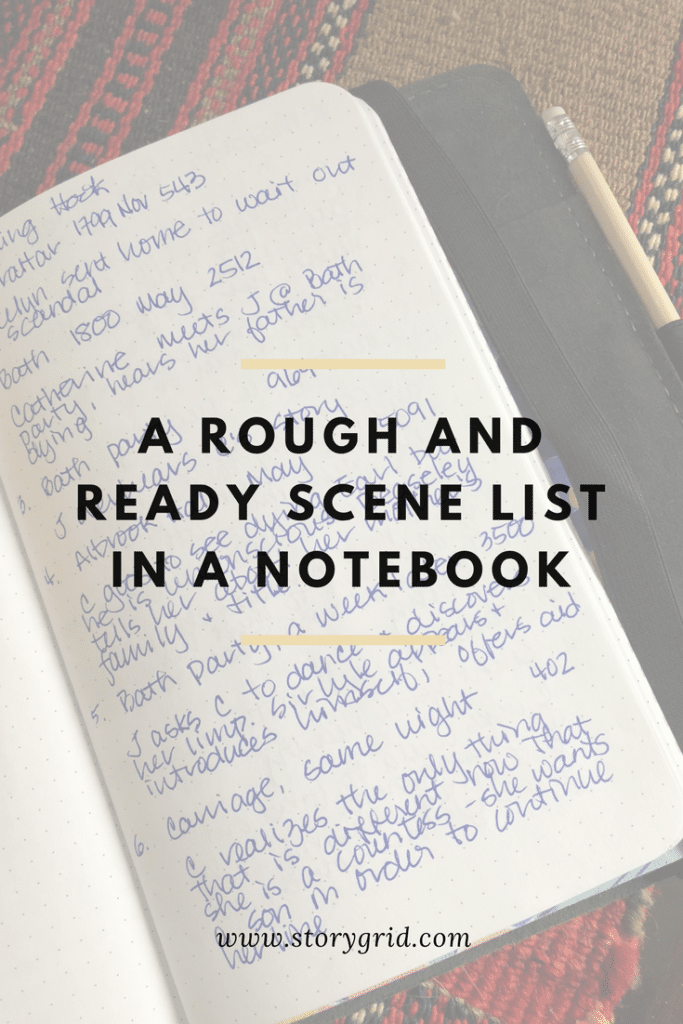
Split your story into Beginning Hook, Middle Build, Ending Payoff to check your story arc
Shawn’s rule of thumb is 25% Beginning Hook, 50% Middle Build, 25% Ending Payoff. However, that is normally the RESULT when you’ve written a story that works! Instead, you may see problems here if your numbers are “off.” Sometimes when I start a book I ramble and explain as I try to get going, and my Beginning Hook ends up being much too long. I saw this immediately in one of my novels; the Beginning Hook was longer than the Middle Build! That’s all right; that’s why we’re doing this before we try to build a great big spreadsheet with all the material we’re going to delete anyway.

Uh-oh is right! That’s a ridiculous beginning hook!
Next, look for the Inciting Incident, Progressive Complication, Crisis, Climax, and Resolution in each of those three segments. Note them down on your list and assess them critically. Are the Progressive Complications in each section becoming “progressively” more complicated? Does each Crisis moment have higher stakes? Is each Climax (protagonist’s decision) increasingly irreversible? Is the Ending Payoff surprising but inevitable? Do the Resolutions of the first two sections lead into a big Inciting Incident for the third?
If you told your story to a friend based on these three sections, would it be exciting?
If you see problems with this skeletal view of your story, rejoice—it’s easier to fix this perspective now than when you are deep in the weeds doing scene work. My stories both suffered from complications that were too tame and crises without truly high stakes.
But wait, don’t fix anything yet. Just take notes. Seriously! If you start fixing before you know everything that is wrong, you’ll drive yourself mad.
Look for missing genre conventions and obligatory scenes
One of my books is a contemporary romance. When I re-read the manuscript, I decided that my “quiet” heroine was actually just boring. But thanks to Story Grid, I knew that choosing an internal genre to torment my lead characters would result in a more interesting love story, so I decided that this book would be a Love Story External Genre with a Worldview/Maturation Internal Genre. Some of this was already baked into my romance plot, but my goal was to create something that was less “quiet,” so I would need to have my characters do things that would demonstrate personal growth even as their personal trajectories clashed with the romance story.
The other book is a historical romance, longer and more complex. I knew that Love Story would be the External Genre, but I didn’t really have any thoughts as to Internal Genre until one of my Story Grid editor colleagues pointed out the obvious status themes in the story. Wow! That was a major a-ha moment. So that book would have an Internal Genre of Status Story.
I made lists of the obligatory scenes and conventions for the genres I had chosen, and started looking for them in my scene list. One of the first things I noticed was the lack of a love triangle in one of the books—oops, that’s a big fail! I also realized that the antagonist in the historical romance wasn’t villainous enough, and that I was shying away from what should have been a shattering all-is-lost moment.
Make a list of missing scenes and conventions. You’ll need to have all of these in your Professional First Draft. Also note any obvious weak moments, especially in the obligatory scene list.
Create a new Foolscap with an improved Beginning Hook, Middle Build, and Ending Payoff
Now you’ll reconstruct your Beginning Hook, Middle Build, and Ending Payoff. Use a blank Foolscap or just a sheet of paper. After I split my manuscript into the three major parts, I saw that I needed more and better conflict, and I knew that I needed my complications to get worse and more irreversible as the story went on. I also had my list of missing obligatory scenes and conventions—I made sure to get all of those in my new plan. My Beginning Hook was too long and wordy but all of the requisite pieces were there—I could cut the verbiage later. It was the Middle Build where things went flat, so I focused on making the Crisis more powerful, with a Resolution that would take us right into a big, stressful result and fuel the Ending Payoff. Remember my missing love triangle? I invented a new character to create some trouble between the hero and heroine, and then escalated it.
This process was actually fun, because I was thinking about real people (well, fictional real people!) and what I could do to them. In my historical novel, my heroine runs away when she realizes that she can’t stop the villain from being villainous. The hero steps in to foil the villain’s plans, and then chases down the heroine. But this is way too easy and not satisfying enough. I began to think about how I could twist the knife so that the complications would be dire and more drastic decisions would be called for from both hero and heroine.
That was when I realized that the internal genre was the important missing piece. I hadn’t known about internal genres when I originally wrote the book so I just wrote what the characters did, and not why they did it. If you had asked me why they were doing what they were doing, I would have answered that it was because they love each other, since it’s a love story. But it’s a much better story when the characters are driven by their own internal wants and needs. The conflict between these wants and needs with the global genre is what makes a book dramatic. Why does Mr. Darcy save the Bennetts? You could say that he does it for Elizabeth, but a large part of the story is his own growth as a person. He does it for his own sense of honor and generosity. This confluence is what makes Pride and Prejudice not just a good romance, but a great romance.
Fortunately, these questions are easier to answer AFTER you’ve written a first draft, even an amateur first draft. Think “aspirationally.” Write your plans out, but in terms of the story you WANT to write, not the draft you already DID write.
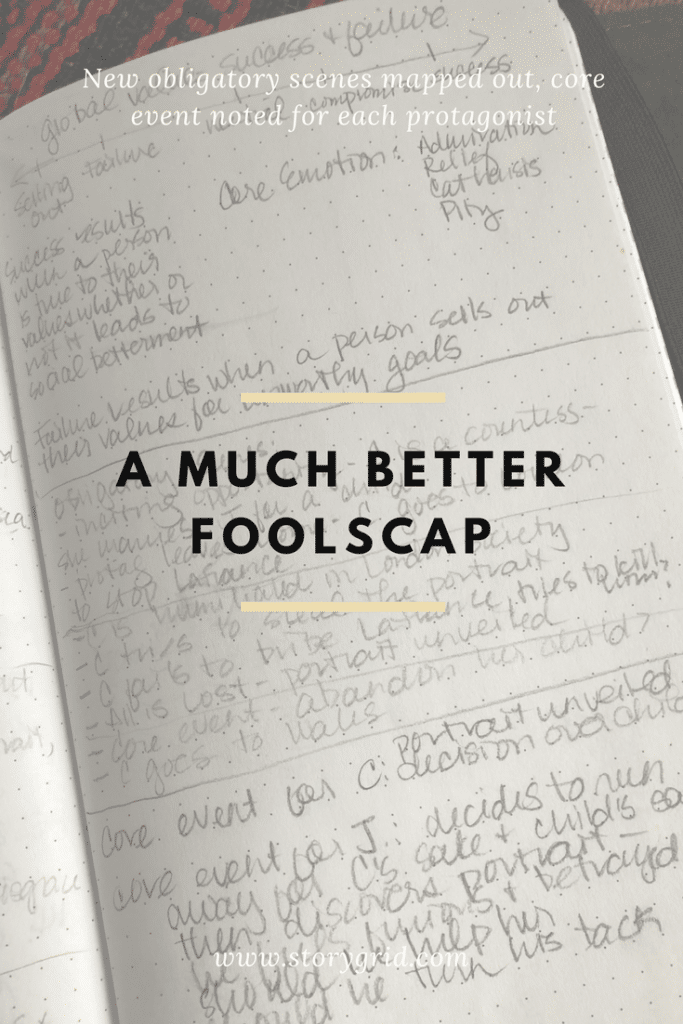
Is the Core Event on your new Foolscap?
I had not focused on a single Core Event as the turning point for the global story—oops! Everything needs to build toward this Core Event. It’s what the reader is waiting for. It typically comes toward the end of the Middle Build, and the Resolution drives you into the Ending Payoff.
In my historical romance, the Core Event is a moment where the hero learns something about the heroine that she has spent the entire novel trying to hide. The villain tells him the secret, and is about to reveal this secret to the world. It works just fine as a Core Event, except I didn’t build up to it terribly well and I pulled my punches by resolving it too easily when it happened. Frankly, it needs to be more awful and more shocking than the way I wrote it.
This was made evident when I realized that the logical internal genre for this story was the Status Story. A Status Story is a type of Hero’s Journey where the protagonist is forced to decide whether achieving status is worth betraying his own sense of honor or morality. The Core Event is the moment where the protagonist makes that decision. It combines with the Love Story well in that this can also be a Proof of Love moment. When I realized this, planning the crisis in the Middle Build was easy. And fortunately, the scene itself in my draft was good. What wasn’t good was the lead-up and the resolution of the scene. The scene would have felt more dramatic if the events leading up to it had created more of a sense of dread for the reader, and if the hero were obviously conflicted about whether he wanted to save the heroine’s reputation or not (what a cad, right?).
Make sure you know what the Core Event of your novel is going to be, and make sure you know when it needs to happen. The events leading up to it and resulting from it will need particular care. If you did a bad or sloppy job here, it’s worth spending the time trying to fix it.
Use Wants and Needs analysis to check your Ending Payoff
At the beginning of every story we have characters who want things. Typically, these wants conflict with their true “needs.” As Shawn points out in The Silence of the Lambs, Clarice Starling wants to rise in the FBI, but needs to deal with her past trauma. Her wants and needs conflict with each other over the course of the story, and it makes for great drama.
When I reached the Ending Payoff for my contemporary romance, I was stuck. I had planned the new Middle Build by throwing a nice little Molotov cocktail into my protagonist’s life and creating a crisis that was deeply upsetting. I knew that this was a Courtship Romance, which means “happily ever after” is a requirement; I also knew that the internal genre was Worldview/Maturation, which means that my characters need to learn something. How would I engineer a surprising but inevitable end?
I went back to Wants and Needs. In the Silence of the Lambs, Clarice Starling goes into the Ending Payoff risking the thing she’s always wanted (the FBI) in order to do what she needs to do (prevent another murder). My suggestion: write out your wants and needs specifically for your protagonist. You can have multiple needs, too, from scene to scene, as long as they are facets of the “big need.” For example, my hero “wants” the heroine, but “needs” to actually let her choose the other guy, and when asked, “needs” to help her get to him. That’s the only way in which he will grow as a person and understand what it’s like to not always win his battles. I wrote this out and kept it in front of me as I planned the Ending Payoff.
Finally: use a graph to map out your new arc
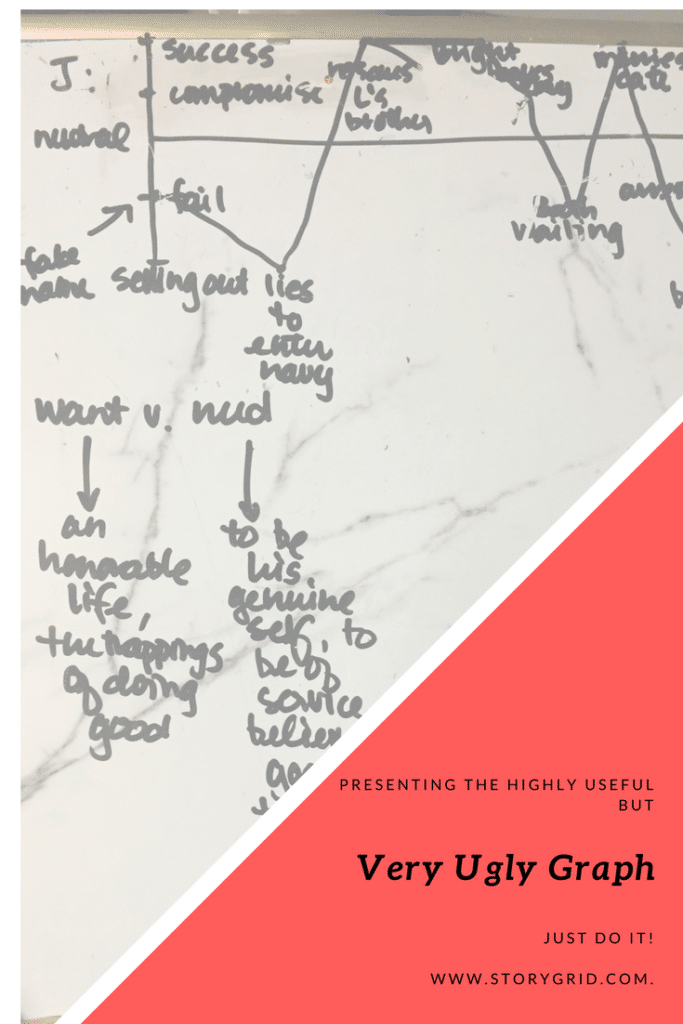
When you’ve got that new-and-improved story plan in hand, there is one last way to check your story arc. Grab a piece of paper and a crayon and graph your novel. No, don’t do a big, complicated thing—this is why I suggest a crayon (I use a whiteboard so I can erase). Do a rough graph with the value scale of your global genre on the Y axis and with the X axis representing scenes. Then for each scene, ask yourself if you are closer to the ultimate positive end (in a Courtship Romance this would be Commitment) or ultimate negative end (Hate Masquerading as Love).
Ideally, you want to see a graph that shows dramatic movement over the course of your story. If you don’t reach the ultimate peak or valley of your genre’s value at stake, then your novel is going to feel flat. If you zig and zag too much from peak to valley, you’re going to make your reader seasick and exhausted—zigging and zagging is great, but not from extreme to extreme in consecutive scenes. In particular, pay attention to the Middle Build, which tends to get monotonous if you aren’t escalating your progressive conflicts and making them more and more stressful for your protagonist. See if you can up the stakes by having the internal genre value move in the opposite direction from the external genre value.
The graph is also a tool for the personal journey of your protagonist. I try to draw a quick sketch of each character’s proximity to the top or the bottom of the Y axis for the internal genre. In my historical romance, the internal genre is a Status Story, so the value range would be “selling out” at the negative end and “success” (in achieving status) at the positive end. In the photo of my white board, I am trying to get my hero through the middle build, and knew I needed to have his personal sense of self-worth and honor tank before I could throw him into an incident designed to prod him into doing something hero-worthy. These quick graph sketches are useful because you can impose other trajectories on top of whatever you’re working on. I can put the heroine’s state of mind on top of this, as well as the global romance plot (by having another Y axis with romance values from love to hate to hate masquerading as love).
Writing your “new” first draft
The secret here is to WORK AS QUICKLY AS YOU CAN. You’re not writing a second draft. You’re simply filling in the gaps in your first draft and ditching anything that doesn’t move. Give yourself permission to do a less-than-perfect job, because what you want is to get to the point where you can spreadsheet the draft and start to do some serious editing. All you’re doing is CPR.
First, look at your list of scenes. Remember where you marked out the Beginning Hook, Middle Build, and Ending Payoff? Find the scenes making up the fifteen big events (Inciting Incident, Progressive Complication, Crisis, Climax, Resolution) that you’ve re-designed in your new-and-improved story plan. If you need to write new scenes, note that in your list and stick them into the right places.
Look at the proportions. Are your Beginning Hook, Middle Build, and Ending Payoff in a roughly 25%-50%-25% format? Note any weak scenes or subplots that aren’t related to your global story. When you go into the manuscript, you want these flagged so that you can eliminate anything that isn’t important to the story. If this makes you nervous, just save your snippets somewhere.
If you have the reverse problem (e.g. the middle build is too short), note this as well. Did you have any missing obligatory scenes? A good rule of thumb is that these, too, are often distributed in a 25%-50%-25% format. Out of eight obligatory scenes, for example, it often works to put four in the middle build.
Now you can start your rewrite. Work one piece at a time (Beginning Hook, Middle Build, Ending Payoff). However, as you write, check back on any graphs that you might have used to create that new and improved story plan, and any Wants and Needs lists. As you move through each scene, ask yourself where you are on that graph and where the characters are with regard to acquiring what they need.
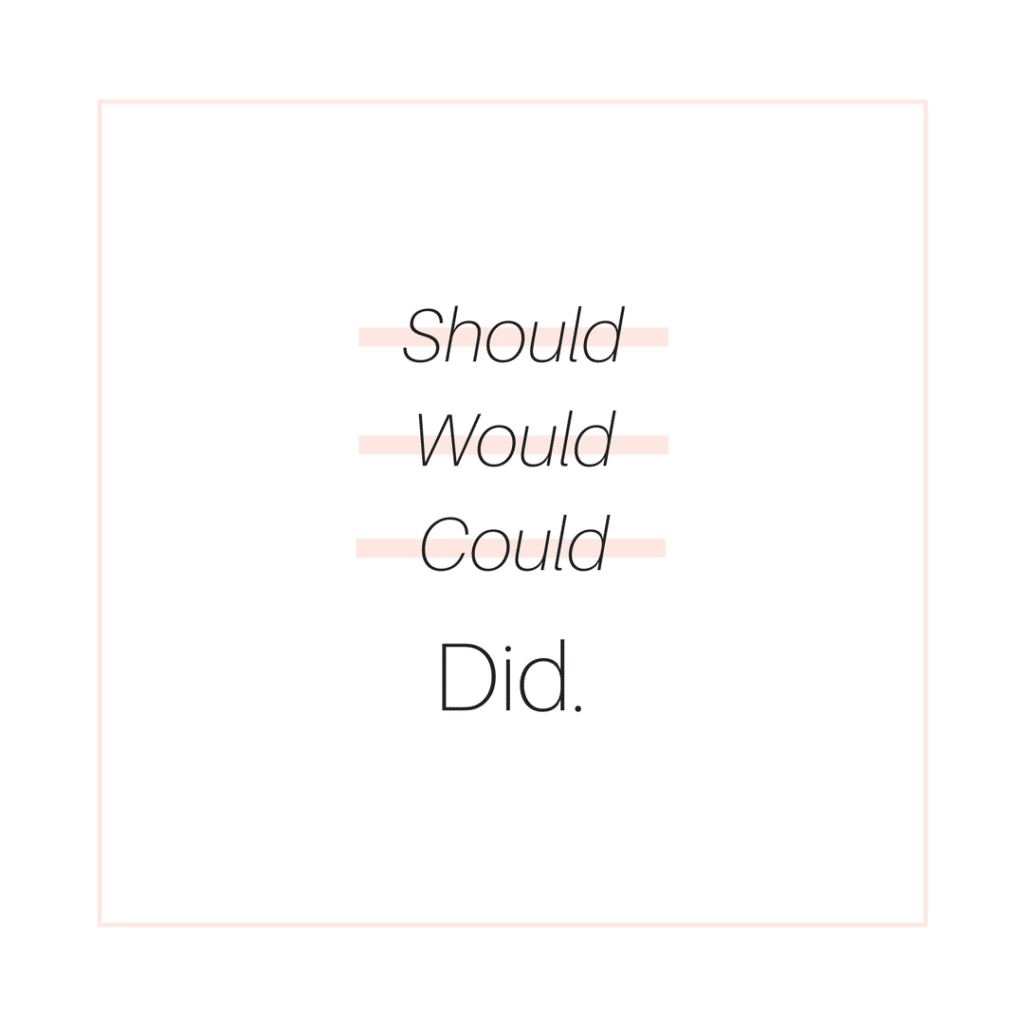
At the end of this draft, celebrate! You’ve got a Professional First Draft. You fought Resistance and won. You can now enter the realm of the Story Grid Spreadsheet, which is a rite of passage indeed. You’re past probably 99% of all writers out there, and the odds are terrific that you will go on to complete a book that works.
(Shawn says you can take a few days off now before you head into the Spreadsheet. LOL)